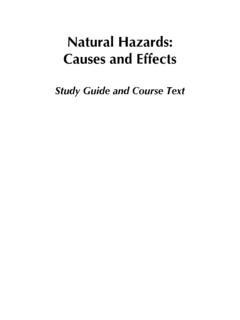Transcription of CONCEPTS OF HAZARDS, DISASTERS AND HAZARD …
1 Capacity Building in Asia using Information Technology Applications (CASITA) Module 2. CONCEPTS OF hazards , DISASTERS AND. HAZARD ASSESSMENT. Goals To instill an understanding of the CONCEPTS of hazards , multiple hazards and disaster To develop the capability for HAZARD assessment Keywords/phrases HAZARD Learning outcomes natural After completing this session, you will be able to man-made perform a HAZARD identification and assessment for a technical na-tech selected community. human intervention Learning objectives magnitude As you work through this session you will learn to frequency intensity 9 Distinguish between the CONCEPTS of HAZARD , HAZARD rate of onset event, secondary hazards , multiple hazards and classification disaster 9 Classify and describe types of hazards identification assessment 9 Explain HAZARD characteristics such as magnitude, mapping frequency, intensity and rate of onset and their Multiple hazards importance 9 Conduct HAZARD identification, HAZARD assessment and HAZARD mapping and explain their functional value.
2 1. Definition of HAZARD "Those elements of the physical environment, harmful to man and /. caused by forces extraneous to him" (Burton et al 1978). Standards Australia (2000) defines a HAZARD as A source of potential harm or a situation with a potential to cause loss.'. A natural event that has the potential to cause harm or loss. -ADPC.. This course material is being made available by Asian disaster Preparedness Center (ADPC), Bangkok under Capacity Building in Asia using Information Technology Applications (CASITA). project, to the participating universities and institutions for educational purpose only. Reproduction of materials for educational purpose is encouraged as long as ADPC is acknowledged. 1. Capacity Building in Asia using Information Technology Applications (CASITA) Module 2.
3 A HAZARD is a threat. A future source of danger. It has the potential to cause harm to People - death, injury, disease and stress Human activity economic, educational etc. Property - property damage, economic loss of Environment - loss fauna and flora, pollution, loss of amenities. Some examples of hazards are earthquakes, volcanic eruptions, cyclones, floods, landslides, and other such events. 2. HAZARD Event It is the physical parameter of the HAZARD event that causes the harm. Environmental events become hazards once they threaten to affect society and/or the environment adversely. A physical event, such as a volcanic eruption, that does not affect human beings is a natural phenomenon but not a natural HAZARD . A natural phenomenon that occurs in a populated area is a hazardous event.
4 A hazardous event that causes unacceptably large numbers of fatalities and/or overwhelming property damage is a natural disaster . In areas where there are no human interests, natural phenomena do not constitute hazards nor do they result in DISASTERS . For information on natural DISASTERS , refer to: The OFM/CRED . International disaster Database at < >.. Magnitude is an important characteristic for analyzing hazards since only occurrences exceeding some defined level of magnitude are considered hazardous. The level of harm is governed by Magnitude of the HAZARD Frequency of HAZARD or recurrence Intensity at the impact point Multiple hazards When more than one HAZARD event impacts the same area, there arises a multiple HAZARD situation. These different HAZARD events may occur at the same time or may be spaced out in time.
5 2. Capacity Building in Asia using Information Technology Applications (CASITA) Module 2. The planning process in development areas does not usually include measures to reduce hazards , and as a consequence, natural DISASTERS cause needless human suffering and economic losses. From the early stages, planners should assess natural hazards as they prepare investment projects and should promote ways of avoiding or mitigating damage caused by hazards . Adequate planning can minimize damage from these events. 3. The Return Period Majority of hazards have return periods on a human time-scale. Examples are five-year flood, fifty-year flood and a hundred year flood. This reflects a statistical measure of how often a HAZARD event of a given magnitude and intensity will occur. The frequency is measured in terms of a HAZARD 's recurrence interval.
6 For example, a recurrence interval of 100 years for a flood suggests that in any year, a flood of that magnitude has a 1% chance of occurring. Such extreme events have very low frequencies but very high magnitudes in terms of destructive capacity. This means that an event considered being a hundred year flood would cause severe damage compared to a five-year flood. 4. Classification of hazards Are hazards natural ? There are many different ways of classifying hazards . One is to consider the extent to which hazards are natural . I. natural hazards such as earthquakes or floods arise from purely natural processes in the environment. II. Quasi- natural hazards such as smog or desertification arise through the interaction of natural processes and human activities. III. Technological (or man-made) hazards such as the toxicity of pesticides to fauna, accidental release of chemicals or radiation from a nuclear plant.
7 These arise directly as a result of human activities. Hewitt and Burton (1971) itemized a variety of factors relating to damaging geophysical events, which were not process-specific, including 3. Capacity Building in Asia using Information Technology Applications (CASITA) Module 2. Aerial extent of damage zone Intensity of impact at a point Duration of impact at a point Rate of onset of the event Predictability of the event. A typology based on Hewitt and Burton (1971) would appear as follows. 1. Atmospheric Atmospheric Single element Combined elements/events Excess rainfall Hurricanes Freezing rain (glaze) Glaze' storms Hail Thunderstorms Heavy snowfalls Blizzards High wind speeds Tornadoes Extreme temperatures Heat/cold stress 2. Hydrologic 3. Geologic Floods river and coastal Mass-movement Wave action Landslides Drought Mudslides Rapid glacier advance Avalanches Earthquake Volcanic eruption Rapid sediment movement 4.
8 Biologic 5. Technologic Epidemic in humans Transport accidents Epidemic in plants Industrial explosions and fires Epidemic in animals Accidental release of toxic Locusts chemicals Nuclear accidents Collapse of public buildings natural hazards and human intervention Although humans can do little or nothing to change the incidence or intensity of most natural phenomena, they have an important role to play in ensuring that natural events are not converted into DISASTERS by their own actions. It is important to understand that Human intervention can increase the frequency and severity of natural hazards . For example, when the toe of a landslide is removed to make room for a settlement, the earth can move again and bury the settlement. 4. Capacity Building in Asia using Information Technology Applications (CASITA) Module 2.
9 Human intervention may also cause natural hazards where none existed before. Volcanoes erupt periodically, but it is not until the rich soils formed on their eject are occupied by farms and human settlements that they are considered hazardous. Human intervention reduces the mitigating effect of natural ecosystems. Destruction of coral reefs, which removes the shore's first line of defense against ocean currents and storm surges, is a clear example of an intervention that diminishes the ability of an ecosystem to protect itself. An extreme case of destructive human intervention into an ecosystem is desertification, which, by its very definition, is a human-induced " natural " HAZARD . Quasi- natural and na-tech are terms used to denote such hybrids. If human activities can cause or aggravate the destructive effects of natural phenomena, they can also eliminate or reduce them.
10 Controllable events vs. immutable events For some types of hazards the actual dimensions of the occurrence may be altered if appropriate measures are taken. For others, no known technology can effectively alter the occurrence itself. For example, construction of levees on both sides of a stream can reduce the extent of inundations, but nothing can moderate the ground shaking produced by an earthquake. 5. More HAZARD Terminology Secondary hazards These are hazards that follow as a result of other HAZARD events. hazards secondary to an earthquake may be listed as follows to illustrate the concept . Primary HAZARD is the earthquake. Secondary hazards are Building collapse Dam failure Fire Hazardous material spill Interruption of power/ water supply/. communication/ transportation/ waste disposal Landslide Soil liquefaction Tsunami (tidal wave).









